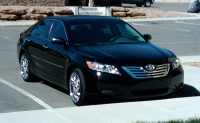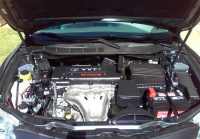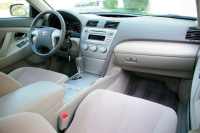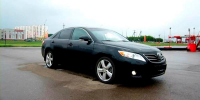Toyota Camry passenger car in 2007 has undergone small changes, which allowed to eliminate the disadvantages of the new generation XV40. Sedans have a solid construction and are common on the roads of the country and the secondary market.
Description of the 2007 Toyota Camry  Cars Camry 2007 model year were offered to customers in several options of equipment. Traditionally, Toyota has not provided additional options (except for painting with metallic effect materials or additional elements installed by the dealer). The manufacturer has divided body design into standard and prestige lines.
Cars Camry 2007 model year were offered to customers in several options of equipment. Traditionally, Toyota has not provided additional options (except for painting with metallic effect materials or additional elements installed by the dealer). The manufacturer has divided body design into standard and prestige lines.
The base model, dubbed Camry, was offered in all markets, while the prestige model, dubbed Toyota Aurion, was targeted at Australia and the Middle East.
Car exterior
The sedan received a body with rounded edges and a sloped forward hood. The front bumper with integrated decorative grille with increased length provided protection in collisions at speeds up to 5-7 km/h.
Headlights with lenses improved illumination of the road, and some trucks were offered with xenon headlights. The fog lights in the lower part of the bumper had rounded reflectors, and there were no turn signals on the front fenders.
The bodywork had smooth surfaces and aerodynamic flats around the perimeter of the wheel arches to reduce contamination.
The factory-applied safety glass was green athermal, and some trucks had factory-tinted glass.
The base models had stamped wheels with decorative hubcaps, while the improved versions used light-alloy wheels with diameter of 16 or 17″ (tire size - 215/60R16 or 215/55R17).
Main advantages
Advantages of cars, noted by the owners:
reliability of the main units and running gear;
liquidity in the secondary market;
high level of comfort;
spacious luggage compartment;
extended set of safety systems;
simplicity and low maintenance costs;
large number of spare parts from alternative manufacturers.
Technical Specifications
The XV40 generation had a 4-door sedan body, made of rolled steel. Alloy steel elements were used to increase rigidity, and programmable deformation zones were included. The power plant was located in the front end, the torque was transmitted by half-axles with constant velocity joints. Anti-slip regulation was fitted by default to reduce fuel consumption and acceleration time in slippery road conditions.
Basic parameters
The suspension was wishbone and shock absorber with coil springs. The stiffness of the struts depended on the market and type of powertrain. The steering retained the hydraulic power steering, and there was a control unit for adjusting the steering inputs to match the speed of the truck. The rack and pinion steering were connected to the knuckles by lugs with adjustable length section and ball pins with protective sleeves. The manufacturer offered a hybrid modification, which was available in Australia, USA and Canada. The trucks were differed by design of instrument cluster, which had an indicator of a power plant operating modes. The cars were equipped with electric power steering and original power brakes and air conditioning compressor, which could work when the internal combustion engine was off.
Dimensions
Main dimensions:
distance between wheel axles - 2776 mm;
body length - 4806 mm;
width (excluding mirror housings) - 1821 mm;
height - not more than 1471 mm;
ground clearance - not less than 135 mm;
Front/rear track - 1575/1565 mm.
Engine  The base engine was a 2.4-liter 2AZ-FE with VVT-i variable valve timing system and 16-valve cylinder head. The engine had a power of 167 hp and could be combined with gearbox E351 (all five forward speeds synchronized) or with a 5-speed automatic transmission model U250E. For the U.S. was available a hybrid version with variator eCVT P311. More expensive modifications were available with V-shaped 277-horsepower 3.5-liter gasoline engine 2GR-FE, working with a six-speed automatic U660E. The Japanese market had a right-hand drive version with a 165-horsepower 2AZ-FE engine with all-wheel drive. The trucks differed by usage of the U241E four-speed automatic transmission. The transmission had additional gears, viscous clutch and a cardan shaft. The trucks were equipped with shock absorbers with adjustable stiffness.
The base engine was a 2.4-liter 2AZ-FE with VVT-i variable valve timing system and 16-valve cylinder head. The engine had a power of 167 hp and could be combined with gearbox E351 (all five forward speeds synchronized) or with a 5-speed automatic transmission model U250E. For the U.S. was available a hybrid version with variator eCVT P311. More expensive modifications were available with V-shaped 277-horsepower 3.5-liter gasoline engine 2GR-FE, working with a six-speed automatic U660E. The Japanese market had a right-hand drive version with a 165-horsepower 2AZ-FE engine with all-wheel drive. The trucks differed by usage of the U241E four-speed automatic transmission. The transmission had additional gears, viscous clutch and a cardan shaft. The trucks were equipped with shock absorbers with adjustable stiffness.
Interior equipment  The car was equipped with separate front seats and a rear sofa with a total seating capacity of 5 people. The standard equipment included a center console with armrest and storage niches for small items. A dimmable, dial-type instrument cluster and display allowed the driver to monitor and display information as needed. The standard equipment included an adjustable steering column in two positions, and a 1-zone climate control (expensive versions used 2-zone). The 2007 Camry was equipped with a CD player and four loudspeakers, and the steering wheel had adjustment buttons. Six airbags, electrically adjustable side windows and mirrors were an advantage. Fabric or imitation leather were used for the upholstery of the seats and elements of the door cards. The interior trim includes plastic plates, imitating wooden panels.
The car was equipped with separate front seats and a rear sofa with a total seating capacity of 5 people. The standard equipment included a center console with armrest and storage niches for small items. A dimmable, dial-type instrument cluster and display allowed the driver to monitor and display information as needed. The standard equipment included an adjustable steering column in two positions, and a 1-zone climate control (expensive versions used 2-zone). The 2007 Camry was equipped with a CD player and four loudspeakers, and the steering wheel had adjustment buttons. Six airbags, electrically adjustable side windows and mirrors were an advantage. Fabric or imitation leather were used for the upholstery of the seats and elements of the door cards. The interior trim includes plastic plates, imitating wooden panels.
Operating precautions
When operating the vehicles, it is necessary to adhere to the factory recommended service interval every 10 thousand km. The service book contains a list of works and necessary consumables. The cars are equipped with a diagnostic system with non-volatile memory, storing the error codes. It is recommended to periodically check the electronics and control units with a scanner or laptop (the equipment is available at specialized service stations).
Fuel consumption
Minimum fuel consumption has machines with a 2.4-liter power unit, on the highway car fits in 7.8 liters per 100 kilometers, in the mixed cycle parameter is 9.9 liters. In a city stream the car requires 13.6 liters (factory values), with the wear and tear of the engine and box consumption increases. The modification with a 3.5-liter engine consumes 14.1 liters per 100 kilometers in traffic jams.
Problems that can be encountered
The engines used in cars have a service life of up to 400,000 km, provided that they are serviced in time. Coolant pump can withstand 70-90 thousand km, in case of destruction of the node there is extraneous noise and antifreeze leakage. Throttle block requires periodic cleaning from dirt (otherwise there is a risk of permanent damage). Owners have noted frequent failures of the overrunning clutch located on the alternator pulley (the part is available on the aftermarket). The 2.4 L engine is sensitive to overheating, and with mileage greater than 100 thousand km, oil consumption can increase. To eliminate the defect, it will be necessary to install new oil caps. A number of owners note damage to the threads in the body of the block, intended for the studs fixing the head. On 3.5 liters engines can leak oil cooler lines (later the manufacturer began using metal tubes with increased strength). When starting the power units may crackle, caused by the operation of the clutch of the variable valve timing mechanism. The noise is not a sign of malfunction, some owners put new clutches. Owners of cars with an automatic 5-speed gearbox note breakdowns of the selector switch sensor and control unit. The unit with 6 steps can not withstand sharp starts, there are jerks and knocks when shifting. Repair consists in reassembly of the unit with flushing of hydraulic block and installation of new friction clutches. During operation, drivers are faced with knocking and backlash of the cardan joint in the steering. Brake discs overheat and deform under active use, which causes the pedal and steering wheel to wobble. The owner needs to regularly service the calipers and clean the pad guides of corrosion, otherwise the mechanisms will jam.
Disadvantages of the car
These include:
increased fuel consumption;
insufficient efficiency of the head lights;
Increased consumption of engine oil (on versions with a capacity of 2.4 liters);
poor noise isolation;
low quality of chrome, which becomes cloudy under the influence of reagents;
sluggish suspension, which reduces the comfort of the interior.
Most recent

